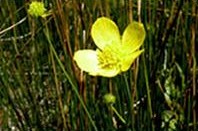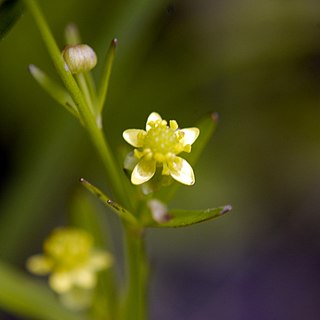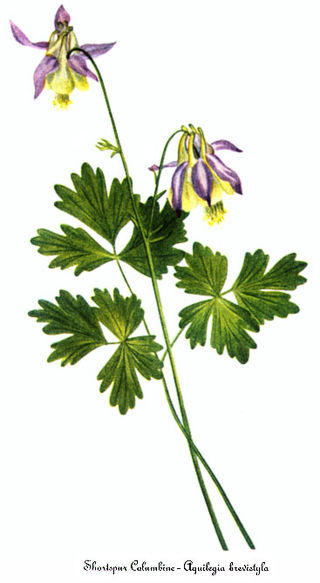
Kumlienia hystricula is a species of flowering plant in the buttercup family known by the common name waterfall false buttercup.

Lithophragma cymbalaria is a species of flowering plant in the saxifrage family known by the common name mission woodland star.

Ranunculus alismifolius is a species of buttercup known by the common name plantainleaf buttercup. It is native to western North America from British Columbia to California to Colorado, where it grows in moist mountain habitat such as meadows, streambanks, and bogs, becoming common to abundant in some places. It is somewhat variable in appearance and there are several varieties which can be hard to tell apart. In general the plant is a perennial herb producing a few usually upright to erect, branching stems from a fleshy, fibrous root system. It can be up to half a meter tall, or it can remain quite short and clumpy. The leaves vary in shape, the lower ones with oval blades and the upper linear to lance-shaped, all borne on long petioles. The inflorescence bears one or more flowers, each on a long pedicel. The flower has up to 12 yellow petals and many yellow stamens and pistils at the center. The fruit is an achene, borne in a spherical cluster of 12 or more.

Ranunculus andersonii is a species of buttercup known by the common name Anderson's buttercup. It is native to the western United States, including the Great Basin and surrounding regions, where it grows in sagebrush, woodlands, and other habitat. It is a perennial herb producing a basal rosette of thick leaves which are each divided into three double-lobed leaflets at the end of a petiole. The inflorescence arises from the rosette on an erect, leafless stalk usually no more than 20 centimeters tall. It bears one flower with usually five white or red-tinged petals each up to 2 centimeters long with white or pinkish sepals at the base. At the center of the flower are many yellow stamens and pistils. The fruit is an achene, borne in a spherical cluster of 14 or more. It was named after Charles Lewis Anderson by Asa Gray.

Ranunculus eschscholtzii is a species of buttercup flower known by the common name Eschscholtz's buttercup.

Ranunculus flabellaris is a species of flowering plant in the buttercup genus, Ranunculus, known by the common name yellow water buttercup. It is native to much of North America, including the southern half of Canada and most of the United States.
Ranunculus gormanii is a species of buttercup known by the common name Gorman's buttercup. It is native to Oregon and northern California, where it grows in the Klamath Mountains and a section of the southern Cascade Range. It can be found in moist areas in mountain forests and meadows. It is a perennial herb producing prostrate stems which extend along the ground up to 20 centimeters in length, sometimes rooting at nodes that come in contact with wet substrate. The leaves have oval blades up to 4 centimeters wide which are borne on petioles up to 7 centimeters in length. Flowers have 5 to 7 shiny yellow petals each a few millimeters long and many stamens and pistils. The fruit is an achene borne in a spherical cluster of up to 15.
Ranunculus lobbii is a species of buttercup known by the common name Lobb's buttercup, or Lobb's aquatic buttercup. It is native to a few areas in western North America, where it is reported from British Columbia, Oregon, and northern California. It is an aquatic plant, growing in various types of shallow-water habitat, including forest ponds and vernal pools. It is an annual herb producing submerged stems 20 to 80 centimeters long which may float at the surface. The blades of the leaves are tiny and divided into threadlike segments. If any leaves develop on stem parts which are exposed to air they are much different in morphology, developing larger, more robust leaves. Flowers have generally 5 petals which are white in color and about half a centimeter long. Many stamens and pistils fill the center of the flower. The fruit is an achene borne in a spherical cluster.

Ranunculus macounii is a species of buttercup known by the common name Macoun's buttercup. It is native to much of North America, from Alaska and northwestern Canada to Newfoundland and Labrador, and the contiguous United States except for the northeast and southeastern areas. It grows in many types of moist habitat, including marshes and wet areas woodlands and scrub. It is generally semi-aquatic, growing in or next to shallow water, or in muddy places. It is a perennial herb producing prostrate, spreading stems that root at nodes that come in contact with moist substrate, or growing erect and branching. The stems are generally hairy, but populations of hairless specimens are known. The leaves are mostly divided into three lobed, toothed leaflets which are borne on long, hairy petioles. The flowers each have five shiny yellow petals under a centimeter long around a center of many stamens and pistils. The fruit is an achene borne in a spherical cluster of 20 or more.
Ranunculus orthorhynchus is a species of buttercup known by the common name straightbeak buttercup. It is native to western North America from Alaska to California to Utah, where it grows in moist areas in many types of habitat, including meadows and marshes.

Ranunculus parviflorus is a species of buttercup known by the common name smallflower buttercup. It is native to Europe, but it is known on other areas of the world as an introduced species and sometimes a roadside weed, for example, in parts of Australia and the United States.
Ranunculus populago is a species of buttercup known by the common names popular buttercup and mountain buttercup. It is native to the Pacific Northwest and surrounding areas in the United States, where it grows in wet habitat, such as bogs, streambanks, and moist mountain meadows. It is a perennial herb producing an upright, mostly hairless stem up to about 30 centimeters in maximum height. Leaves have oval blades borne on long petioles. The flower has usually five or six shiny yellow petals each a few millimeters long around a central nectary and many stamens and pistils. The fruit is an achene borne in a spherical cluster.

Ranunculus sardous is a species of buttercup known by the common name hairy buttercup. It is native to Europe and it can be found in many other areas of the world, including parts of the United States and Australia, as an introduced species and a roadside and lawn weed. It grows in many types of disturbed habitat, especially in moist areas. It is an annual or biennial herb producing a mostly erect, hairy stem up to half a meter tall. The hairy leaves are usually divided into three leaflets which are borne on petioles a few centimeters in length. The flower has usually five yellow petals each up to a centimeter long and five reflexed sepals. The fruit is an achene borne in a spherical cluster of up to 35.

Ranunculus recurvatus, the blisterwort or hooked crowfoot, is a plant species of the genus Ranunculus in the family Ranunculaceae native to eastern North America. It is an early-flowering plant of moist deciduous woods from central Quebec south to Florida.

Stellaria calycantha is a species of flowering plant in the family Caryophyllaceae known by the common name northern starwort. It is native to western North America from Alaska and northwestern Canada to California and New Mexico, as well as eastern Russia. It occurs in subalpine and alpine climates, in many types of moist, shady habitats. It is a rhizomatous perennial herb producing a prostrate to erect stem up to 25 centimeters long, taking a clumpy form. The thin oval leaves have smooth edges and pointed tips, and measure up to 2.5 centimeters in length. The inflorescence bears one or more flowers, each on a long pedicel. Each flower has five pointed green sepals, and some flowers have up to five deeply lobed white petals.

Trautvetteria is a genus of flowering plants in the buttercup family. Today it is often considered a monotypic genus, containing only one species, Trautvetteria caroliniensis, which is known by the common names Carolina bugbane, false bugbane, and tassel-rue. A second species, T. japonica, is now generally considered a variety of this species. The genus is named for the botanist Ernst Rudolf von Trautvetter.

Ranunculus aestivalis is a rare species of buttercup known by the common names fall buttercup and autumn buttercup. It is endemic to the state of Utah in the United States, where it exists only in Garfield County next to the Sevier River. It is restricted to a moist microhabitat in an otherwise dry, open ecosystem, and the amount of available habitat is very limited. This is a federally listed endangered species of the United States. It has been described as "the most graceful and showy members of the genus in the western United States," but also "one of the state's rarest and most restricted plants."

Ranunculus abortivus is a species of flowering plant in the buttercup family, Ranunculaceae. Its common names include littleleaf buttercup, small-flower crowfoot, small-flowered buttercup, and kidneyleaf buttercup. It is widespread across much of North America, found in all ten Canadian provinces as well as Yukon and the Northwest Territories, and most of the United States, except Hawaii, Oregon, California, and parts of the Southwest.
Actaea arizonica is a species of flowering plant in the buttercup family known by the common name Arizona bugbane. It is endemic to Arizona in the United States, where it occurs in Coconino, Gila, and Yavapai Counties. Like some other species in genus Actaea, this plant was formerly included in the genus Cimicifuga.

Aquilegia brevistyla is a species of flowering plant in the buttercup family known by the common name smallflower columbine. It is native to northern North America, where it has a disjunct distribution. Most of its range extends from Alaska through much of Canada, and it also occurs in a few areas in the contiguous United States, such as the Black Hills of South Dakota and central Montana. It is most common in eastern Alaska, Yukon, the southern Northwest Territories, and northern parts of Alberta, Manitoba, and Saskatchewan.















